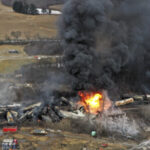A deadly spell of forest fires in Indonesia’s main palm oil producing regions earlier this year may have cost the country $5.2 billion in economic losses, according to the World Bank.
The fires, the worst since 2015, torched about 620,201 hectares of land in the first nine months of the year and affected sectors including agriculture, environmental, transportation, trade and industry, the World Bank said in a report Wednesday.
The economic losses are equal to 0.5% of the country’s annual gross domestic product, the bank estimated. Still, it pales in comparison to the $16 billion of losses from fires suffered by Southeast Asia’s largest economy four years ago.
The hotspots, an annual phenomenon that’s started mainly by illegal land clearance in the tropical forests and peat lands of Sumatra and Borneo, worsened this year as the El Nino weather pattern caused a longer-than-usual dry spell. The haze from the fires blanketed many parts of Southeast Asia, shutting schools, causing respiratory illnesses and forcing airlines to cancel flights.
“The negative impact of forest and land fires are predicted to have consequences beyond this quarter, because production of affected commodities such as perennial crops and timber require at least 2-5 years to harvest,” the World Bank said.
The recurring fires and haze will further increase the negative perception about Indonesia’s palm oil production, the World Bank said. It has already led to falling demand from the European Union and the bloc’s plan to phase out palm oil for use in biodiesel. The spike in fires this year is unlikely help the country’s bilateral talks with the EU at the World Trade Organization, it said.
Tensions between Indonesia and the EU escalated earlier this year after the European Commission decided to place stricter limits on palm oil’s use in biofuels from June on concerns over deforestation.
The emissions from this year’s fires were almost double than the emissions from fires in the Brazilian Amazon, according to the World Bank.
The fires may have released the equivalent of 709 million tons of carbon dioxide through Nov. 15, according to the Copernicus Atmosphere Monitoring Service, a program run on behalf of the European Commission. That’s 22% more than the estimated 579 megatons ejected from burning Amazon forests.
Was this article valuable?
Here are more articles you may enjoy.

 Norfolk Southern to Pay $600 Million to Settle Ohio Spill Case
Norfolk Southern to Pay $600 Million to Settle Ohio Spill Case  Travelers Survey: Distracted Drivers Making US Roads More Dangerous
Travelers Survey: Distracted Drivers Making US Roads More Dangerous  CoreLogic Report Probes Evolving Severe Convective Storm Risk Landscape
CoreLogic Report Probes Evolving Severe Convective Storm Risk Landscape  Oregon Schools Sued for $9M After Young Girl Allegedly Raped
Oregon Schools Sued for $9M After Young Girl Allegedly Raped 